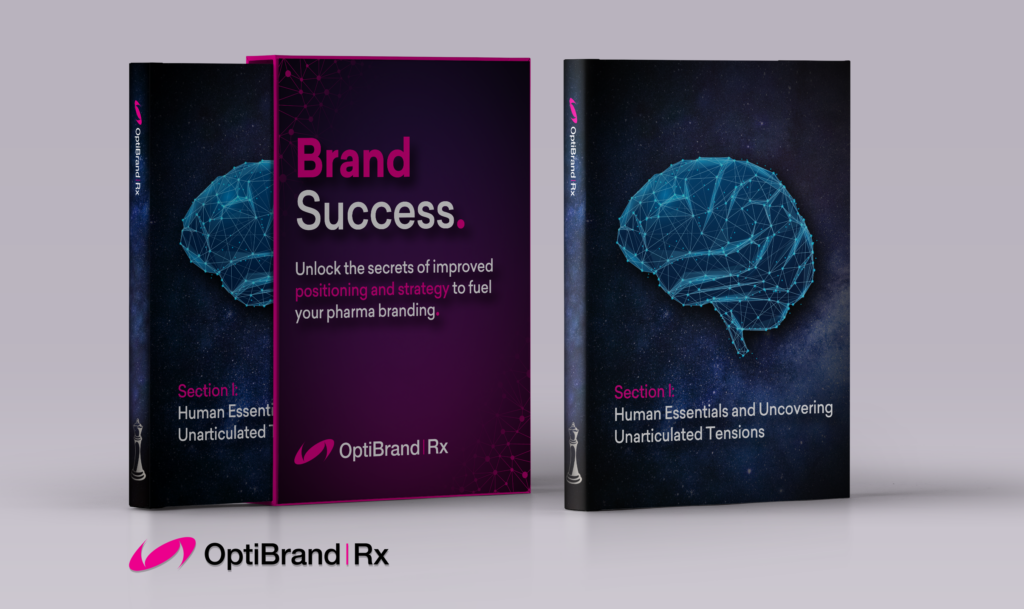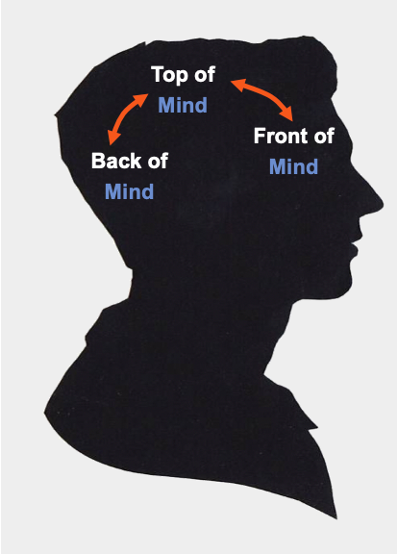
The first chapter in the series will outline the importance of identifying tensions for the success of your brand and provide strategies to successfully achieve this.
The key to achieving behavioral change is understanding how people make decisions. Perceptions and behaviors are entrenched within subconscious decision-making loops which makes transforming perceptions and behaviors exceptionally difficult, but not impossible. Behavioral science experiments repeatedly showcase how people make emotional decisions first, followed by rational justifications. So, if rational thinking only justifies emotional choice, how do you change the emotional connection with your brand? The secret to changing human behavior and perceptions is rooted in a deep understanding of your target customer’s instinctive and automatic decision-making processes.
In pharma this requires a thorough understanding of the “disease consciousness” to uncover tensions in how patients and physicians experience, connect to and manage disease. Finding common tensions and connecting these to emotive territories that the brand can activate allows a brand to position themselves competitively and drive behavior change.
What are Tensions and Why are They Important?
First, it is paramount to define what a tension is and why they are important. Within the subconscious decision-making loop, there are multiple tensions. A tension is something which creates anxiety, trouble or confusion for your target. It is a circumstance which can effect decision making and may even cause decisions to be more difficult or compromised. Understanding this fundamental nuance drives success in brand strategy because by identifying tensions, you can prioritize those which drive the behavior change you desire.
Tensions can be surface level or unarticulated:
| Surface Level | Unarticulated |
| – Easiest to Identify – Smallest in number – Least likely to have a powerful impact/achieve the level of behavioral change required | – Harder to identify – Larger in number – More powerful and more likely to achieve the level of behavioral change required |
Unarticulated tensions exist because there is always a difference of what consumers say they do, what they actually do, and why they do it. In fact, 60 to 65 percent of interpersonal communication is conveyed via nonverbal behaviors (Burgoon et al., 20091).
As such, directly asking your target about tensions in their decision-making process will most likely only unearth surface level tensions. A brand should focus on identifying unarticulated tensions because they are more powerful as they activate and uncover a hidden issue, allowing the reduction in friction in the decision process the target may have forgotten or created a work around that they no longer acknowledged as a problem.
Finally, it must be cautioned that there are many tensions in every decision, and the identification of a tension does not necessarily mean it should or could be activated. Tensions must be prioritized and aligned with what is most likely to achieve the behavioral change that will drive the most success for your brand and is aligned with your brand’s positioning.
Unarticulated tensions are ubiquitous in all industries, so whilst not a unique phenomenon to pharma, often pharma has a heightened challenge in that there are often several unarticulated tensions arising from the multifaceted nature of the industry with many stakeholders involved in any decision-making process. The remainder of this chapter will focus on the identification and prioritization of tensions for the patient and physician.
Identifying Patient’s Tensions: Disease as a Disruption
“Any illness constitutes a disruption, a discontinuance of an ongoing life… The current of daily life is obstructed, perhaps blocked altogether. Illness may revise our conceptions of what is changeable, and we may be forced to change the premises upon which we plan and evaluate our lives.” (Hyden, 19972)
Illness matters to a patient because it is a disruption to their life. The solution, i.e. a medicine or treatment, must help remove or resolve this disruption and importantly, it must not create more disruption. The disruption that a patient experiences may come from a variety of sources, it can be associated directly with the illness or a consequence of the illness/treatment on their personal life, but it is always inextricably tied to the tensions outlined above.
To truly understand the disruption and the tensions experienced, you must be the patient’s ally and focus not on disease management but the “human essentials”. The human essentials are energy, eating, sexuality and sleep, these will later be explained in more detail. But first, it is critical to explain why so many firms fail to activate the behavior change they desire and launch a successful brand. The most common pitfall is focusing on disease management which results in the loss of personal connection with the patient and therefore superficial or unimportant tensions being identified and prioritized. The most important tensions experienced are always directly linked to patient’s personal experience, of which many we share with them because they are the “human essentials”.
It is important to understand that illness is never out of a patient’s mind; it is always within their “disease subconscious”. The disease subconscious is the home of the important unarticulated tensions that a successful brand must unearth. The level of prominence in the “disease subconscious” varies by the point in the patient’s journey and the disease itself – it can be back of mind, top of mind and front of mind. A brand must identify where the tension sits within the disease subconsciousness in order to activate it and understand at what point it can be activated.

Front of mind: Dominates the patient’s mind
Diseases may be heavily front of mind throughout the journey, e.g. NSCLC, Lupus, PsO, or diseases can be front of mind during the later stages e.g. Type 2 Diabetes.
Top of mind: Prominent experience but does not dominate
This is less tied to specific disease state and linked to the impact of planning in order to reduce the impact of the disease on the patient’s life.
Back of mind: Awareness of disease but not prominent in daily life
Diseases can be back of mind throughout the journey, e.g. osteoporosis, but may very quickly jump to front of mind (e.g. experiencing fractures).
How Can You Get Past The Surface Tension and Truly Identify an Unarticulated Tension?
To identify an unarticulated tension you must dig deep into the human essentials and understand the why behind the why behind the why. The researcher must be the patient’s ally and move beyond management of disease and health promoting practices. A successful strategy typically lies in the prioritization of a deeper focus on the four human essentials – energy, eating, sexuality and sleep.
This section will provide a table for each human essential and outline some examples of what the why behind the why really means.
HUMAN ESSENTIAL: ENERGY
A very common surface level tension is reporting feeling more tired, suffering from fatigue or low energy. But what does this really mean? Why is this a problem ? Why is it frustrating? Why is it impacting their lived experience of disease? Where does it sit within the disease subconscious?
| Surface Level Tension | Possible Unarticulated Tensions |
| – Feeling more tired, suffering from fatigue or low energy | – Cognitive challenges Inability to be mentally engaged or think about the future due to a lack of mental energy. – Energy Budgets Forced to prioritize certain activities, to adapt and learn what they are and not capable of doing. This disrupts their sense of self or creates feelings of guilt in their inability to participate in activities. – Unpredictability An emotional toll of apprehension and anxiety may arise if the fatigue experienced is not constant. This many include constantly self-monitoring their energy level and bracing for fluctuations, or despair under the realization a period of low energy is incoming. – Invisible Stigma associated with fatigue and may be mistaken as laziness because it is not visible to family, friends and even HCPs. |
HUMAN ESSENTIAL: EATING
Eating and changes in appetite are common across many illnesses, whether due to the disease itself or the effects of treatment.
| Surface level tension | Possible Unarticulated Tensions |
| – Increased / decreased food intake | – Judgement Beliefs about what a ‘good patient’ should consume. For example, Type 2 diabetes patients may struggle with the strict dietary requirements and feel failure or judgment in their ability to follow these. – Eating as a chore Food symbolizing treatment itself if there is a lack of desire or taste for food. – Antisocial eating and isolation In the presence of judgment, patients may feel isolated and withdraw, eating privately instead of a shared experience. |
HUMAN ESSENTIAL: SEXUALITY
When looking for powerful tensions related to sexuality, many attempts are unsuccessful because they limit the tension to the direct impact of chronic illness on sexual function (e.g. erectile dysfunction). In fact, chronic illness affects both sexual function and sexual wellbeing. Sexual wellbeing is a person’s experience of sexuality, including the impact on relationships.
| Surface Level Tension | Possible Unarticulated Tensions |
| – Reduced sexual function – Loss of libido | – Loss of Identity Sexual intercourse and gender roles are interlocked in many ways. A reduced ability to participate in sexual intercourse impacts a patient’s self-identity, especially if other important gender roles are also impacted by the disease. – Loss of Self Esteem If the disease or treatment impacts/alters a patient’s body image (either literally or mentally) it can have a huge impact on a patient’s sexual identity and desire. |
HUMAN ESSENTIAL: SLEEP
Sleep, whilst interrelated with energy, must be addressed in its own right as fundamental human essential. Sleep is important because whilst it directly impacts energy levels, energy levels are also independent of sleep (e.g., a patient may be tired despite sleeping for many hours).
| Surface level tension | Possible Unarticulated Tensions |
| – Inability to sleep / insomnia | – Outside of society Patients may spend hours awake alone whilst the rest of society sleeps and rests. This can be very lonely or also could result in unhealthy habits around diet or social media. – Late night thoughts Long hours alone with no one to speak to can lead to irrational anxious thoughts related to their disease, treatment and impact on their loved ones. |
Bringing in the Physician
Pharma is unique to consumer marketing, because often it is critical to understand not only the patient’s unarticulated tension, but layer on the physician’s perspective too. As such, activating a patient’s tension must be aligned with the physicians’ beliefs and behaviors and sometimes maybe more important than that of the patients (e.g., in scenarios where the physician has a heavy influence over the treatment decision).
When identifying the tensions which interlace with the physicians, the following framework is helpful:
- What about your product provides something ‘good’ for the patient? This will drive behavior change because it is rewarding for the physician.
- What does your product remove from the experience that other products don’t? This will drive behavior change because it allows the physician to feel relief for the patient.
- What does your product add, which might not be ‘good’, but is to a lesser extent that for the competitors? This will drive behavior change because it provides a reward for the physician (even if to a lesser extent than #1).

1 Burgoon JK, Guerrero LK, Floyd K. Nonverbal Communication.Boston, MA: Allyn and Bacon; 2009
2 Hyden, Lars-Christer; 1997 Illness and narrative. Sociology of Health & Illness. 19(1)48-69
